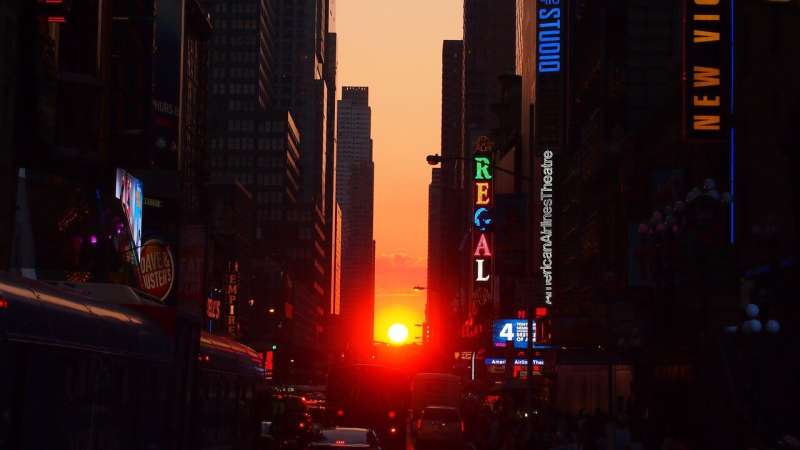This article has been reviewed according to Science X's editorial process and policies. Editors have highlighted the following attributes while ensuring the content's credibility:
fact-checked
reputable news agency
proofread
What is Manhattanhenge and when can you see it?

Twice per year, New Yorkers and visitors are treated to a phenomenon known as Manhattanhenge, when the setting sun aligns with the Manhattan street grid and sinks below the horizon framed in a canyon of skyscrapers.
The event is a favorite of photographers and often brings people out onto sidewalks on spring and summer evenings to watch this unique sunset.
Manhattanhenge happens for the first time this year on May 28 at 8:13 p.m. and May 29 at 8:12 p.m., and will occur again on July 12 and 13.
Some background on the phenomenon:
WHERE DOES THE NAME MANHATTANHENGE COME FROM?
Astrophysicist Neil deGrasse Tyson coined the term in a 1997 article in the magazine Natural History. Tyson, the director of the Hayden Planetarium at New York's American Museum of Natural History, said he was inspired by a visit to Stonehenge as a teenager.
The future host of TV shows such as PBS' "Nova ScienceNow" was part of an expedition led by Gerald Hawkins, the scientist who first theorized that Stonehenge's mysterious megaliths were an ancient astronomical observatory.
It struck Tyson, a native New Yorker, that the setting sun framed by Manhattan's high-rises could be compared to the sun's rays striking the center of the Stonehenge circle on the solstice.
Unlike the Neolithic Stonehenge builders, the planners who laid out Manhattan did not mean to channel the sun. It just worked out that way.
WHEN IS MANHATTANHENGE?
Manhattanhenge does not take place on the summer solstice itself, which is June 20 this year. Instead, it happens about three weeks before and after the solstice. That's when the sun aligns itself perfectly with the Manhattan grid's east-west streets.
Viewers get two different versions of the phenomenon to choose from.
On May 28 and July 13, half the sun will be above the horizon and half below it at the moment of alignment with Manhattan's streets. On May 29 and July 12, the whole sun will appear to hover between buildings just before sinking into the New Jersey horizon across the Hudson River.
WHERE CAN YOU SEE MANHATTANHENGE?
The traditional viewing spots are along the city's broad east-west thoroughfares: 14th Street, 23rd Street, 34th Street, 42nd Street and 57th Street. The farther east you go, the more dramatic the vista as the sun's rays hit building facades on either side. It is also possible to see Manhattanhenge across the East River in the Long Island City section of Queens.
IS MANHATTANHENGE AN ORGANIZED EVENT?
Manhattanhenge viewing parties are not unknown, but it is mostly a DIY affair. People gather on east-west streets a half-hour or so before sunset and snap photo after photo as dusk approaches. That's if the weather is fine. There's no visible Manhattanhenge on rainy or cloudy days.
DO OTHER CITIES HAVE 'HENGES'?
Similar effects occur in other cities with uniform street grids. Chicagohenge and Baltimorehenge happen when the setting sun lines up with the grid systems in those cities in March and September, around the spring and fall equinoxes. Torontohenge occurs in February and October.
But Manhattanhenge is particularly striking because of the height of the buildings and the unobstructed path to the Hudson.
© 2024 The Associated Press. All rights reserved. This material may not be published, broadcast, rewritten or redistributed without permission.



















